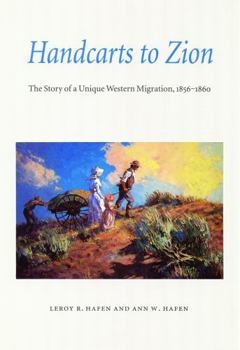Handcarts to Zion: The Story of a Unique Western Migration, 1856-1860
Select Format
Select Condition 
Book Overview
It is unparalleled in history, the procession of Latter-Day Saints pushing handcarts from Iowa City and Florence (Omaha) to their promised Zion by the Great Salt Lake. Many of the three thousand hardy souls who trudged across thirteen hundred miles of prairie, desert, and mountain from 1856 to 1860 were European converts to the Mormon faith. Without funds for wagons and oxen, they carried their possessions in two-wheeled carts powered and aided by...
Format:Paperback
Language:English
ISBN:0803272553
ISBN13:9780803272552
Release Date:April 1992
Publisher:Bison
Length:336 Pages
Weight:1.03 lbs.
Dimensions:0.7" x 6.1" x 9.1"
Customer Reviews
2 ratings
Human spirit, determination
Published by Thriftbooks.com User , 20 years ago
An enticing read of how the Mormon pioneers traversed the plains from Iowa to Salt Lake City in simple hand-crafted carts from 1856-1860. Beginning in Europe, once these destitute, insolvent individuals landed in America, they pulled and pushed their way 1200 miles to the land of Zion. While eight out of the ten handcart companies were sufficiently successful, but still with their own pains and sufferings, the center of attention is on the 4th and 5th companies of 1856. Due to a late start, the Willie and Martin Handcart Companies of 1856 ran into an early, severe Wyoming blizzard, which resulted in many casualties and fatalities. With bone chilling cold, blinding snow, relentless winds, low provisions, fatigue and disorientation, the stories from their diaries and reminisces are shocking. To quote Ephraim Hanks, who was a scout for the first relief party, "Many of the immigrants whose extremities were frozen, lost their limbs, either whole or in part. Many such I washed with water and castile soap, until the frozen parts would fall off, after which I would sever the shreds of flesh from the remaining portions of the limbs with my scissors. Some of the emigrants lost toes, others fingers, and again others whole hands and feet, one woman lost both her legs below the knees and quite a number who survived became cripples for life." We experience the courage and moral strength of these pioneers. The appendixes include letters from Brigham Young defending his views on the handcart method of transportation, regardless of what rumors were circulating. Young further remarks that if anyone blames him for the sufferings of the handcart emigrants, "let the curse of God be on them and blast their substance with mildew and destruction, until their names are forgotten from the earth." Also included in the appendixes is a letter from Millen Atwood who was with the Willie Company. His remarks were, "Since I have arrived I have heard such tales of woe, though I do not know who could have told them to you; we did not suffer much; we had a little bit of snow, but that was nothing; and we had enough to eat as long as it lasted, and when that was gone you furnished us more; we fared first rate." Lastly, Young once again comments that if he had not sent rescue teams, the Lord would have been under obligation to provide assistance by, "sending herds of fat buffaloes to lay down within twenty yards of their camp." An important and captivating read.
A good account of the handcart migration to Utah
Published by Thriftbooks.com User , 22 years ago
When we think of people migrating westward in the 19th century, we tend to think of covered wagons rolling along the Oregon trail. What many of us don't realize is that many people made the trek by handcart--small, wooden carts that they themselves pulled all the way west. These carts, though they had to be pulled by hand, were often able to make the trip in substantially less time than were covered wagons--and at a fraction of the cost.Under the direction of the Mormon church, ten caravans of these carts crossed the plains into Utah. Two of them met with disaster as a result of poor planning among the companies' leadership, but for the most part this form of migration was a successful one.In this book, Hafen gives details about each of the ten companies, including charts showing mileage and number of immigrants. Though the book is tailored to an LDS audience, it's scope is broad, and it should be of interest to anyone wanting to study the colonization of the American West.






